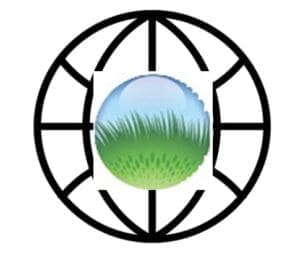 Up-Scaling Vetiver Grass Technology – Using the Internet
Up-Scaling Vetiver Grass Technology – Using the Internet
One important reason, amongst others, why Vetiver Grass Technology (VGT) is not used more widely is that not enough people know about the plant and its many applications. We have to do a better job at marketing, promotion, and Public Relations (PR). We are fortunate to have a 40 year collection of information, data, photographs on our website that provides the evidence and the basis for successfully application of the technology for multiple environmental needs in any country of the world where vetiver will grow. One of the most important tools for this information transfer is the Internet and its various social media platforms. We need to make better use of it. ………. BUT remember up scaling also requires large quantities of low priced, quality vetiver planting material. ….. TENS OF MILLIONS!! The bottom line is that feedback indicates that when people know about vetiver and have a use for it, they use it. We all need to work together so share and promote the applications of this UNIQUE plant.
TVNI’s current Internet related activities
Over the past few weeks the TVNI website has been made more accessible by significantly accelerating the upload time to computers and mobile phones. (PageSpeed Insights measures website performance). In the process, overall “Performance” has increased from 30-40% to just about 100%. Loading time is much quicker (>1 to 2 seconds). There is not much more we can do to further increase performance. Already there is an appreciable increase in users and page views (20-30% up). Currently 50% of the users use mobile phones and 50% use desktop/laptop computers. A high percentage of referrals come from social media platforms with Facebook as the prime referrer.
We need to encourage more potential users to visit, read, and learn from TVNI’s website.
Thus the least cost (virtually free) approach to expanding vetiver knowledge is to increase traffic to TVNI’s knowledge base (the language button in the header bar allows multiple language choices). We encourage greater use of Facebook, Instagram, and YouTube for creation and recording of vetiver content at local level – and the linking of content and posts on these platforms to specific links on TVNI’s website. Apart from a link to https://www.vetiver.org, links to specific page specific topics can be found at: https://www.vetiver.org/network-services/document-center/. When pointing say Facebook readers to TVNI website try and send them to specific pages or posts. If you have an active vetiver related website/Facebook account and you wish to be listed as such on TVNI website please send a request to [email protected]. Posts on social media platforms like Facebook can be further improved if some simple and short text is added to images. Also if the post is sourced it is good etiquette to name the source.
TVNI, as US based non profit, has access to free Google ads. We have now started a program of selective advertising with the objective of bringing more potential and existing VGT users to the TVNI website. The first ads focus on Regenerative Farming, Embedding VS into Farm Systems, Landslides, and Pollution Control. More will follow. The depth of TVNI’s website and available information allows us to create very specific and targeted ads. Existing VS businesses, particularly those in plant supply and VS applications can benefit from this by having their details included in the TVNI’s website Plant Supply page https://www.vetiver.org/vetiver-grass-technology/plant-suppliers/, and Social Media Platform and Affiliates page https://www.vetiver.org/community/vetiver-related-social-platforms/. In order to be included please send to [email protected] the forgoing information, and a one page only description about what your vetiver organization has to offer. We may direct those responding to Vetiver related Google ads to a page on our site that includes your organizations informational description.
 Use of on line posters
Use of on line posters
Recently you may have seen some AI generated posters promoting vetiver. Robinson Vanoh has posted some eye catchers! Some people have questioned their value, but the stats indicate otherwise — they are reaching quite a lot of potential vetiver users – all good publicity. Such posters can be designed to target specific countries (and their culture) for specific vetiver applications. If generated by AI, most need some text overwriting to provide additional information such as a link to a vetiver website.
Story Boards
For those of you who want to create a simple story board for, for example, Vetiver Grass Hedges for Controlling Erosion, this outline (produced by AI) might be useful example as to how you can proceed.
Frame 1: The Problem of Erosion
-
-
- Visual: A barren African landscape with visible signs of soil erosion.
- Caption: “Erosion threatens our fertile lands.”
-
Frame 2: Introducing Vetiver Grass
-
-
- Visual: A healthy vetiver plant with its deep root system.
- Caption: “Vetiver grass, a strong ally against soil erosion.”
-
Frame 3: Traditional vs. Modern
-
-
- Visual: One side showing traditional farming with erosion, the other showing vetiver hedges protecting the soil.
- Caption: “Combining tradition with modern conservation.”
-
Frame 4: Planting Vetiver
-
-
- Visual: Community members planting vetiver hedges along the contours of a farm.
- Caption: “Planting vetiver is planting hope for the future.”
-
Frame 5: The Benefits
-
-
- Visual: A lush farm with rich soil, vetiver hedges in place.
- Caption: “Vetiver hedges help retain water and soil.”
-
Frame 6: A Sustainable Future
-
-
- Visual: Children learning to plant vetiver in school.
- Caption: “Educating the next generation on sustainable farming.”
-
Frame 7: Community Action
-
-
- Visual: A community meeting discussing the implementation of vetiver hedges.
- Caption: “Together, we can protect our land.”
-
Frame 8: The Outcome
-
-
- Visual: A wide-angle shot of vast green fields with vetiver hedges, no signs of erosion.
- Caption: “Vetiver grass hedges: Our shield against erosion.”
-
Frame 9: Call to Action
-
-
- Visual: Contact information for local agricultural services providing vetiver plants.
- Caption: “Join us in controlling erosion. Contact [Local Agency] today.”
-
TVNI Facebook some highlights from February.
New Facebook moderator – Somo Abdul Kadir
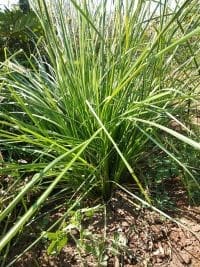
Somo Abdul Kadir of Marsabit (northern Kenya) has kindly agreed to be a moderator. He has a farm near Mt. Marsabit, the latter is an area oasis of about 30,000 ha in an otherwise very arid region of Kenya. He and some of his neighboring farmers are establishing a vetiver program at Marsabit primarily for soil and water conservation, forage improvement, and Regenerative Agriculture with Vetiver (RAV) applications. He is very well read, and often finds vetiver information from various parts of the world that are new to me. I have asked him to be proactive and provocative, and share with our Facebook group globally searched vetiver information with some descriptive text. I hope he will also share some of his daily vetiver activities along with the joys and frustrations of developing a vetiver program from scratch.
Vetiver Unique Living Dam – Chris Wong.
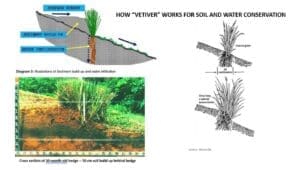 Chris Wong created a nice informatic showing how vetiver works for soil and water conservation and is catching attention with currently a 5,000 post reach.
Chris Wong created a nice informatic showing how vetiver works for soil and water conservation and is catching attention with currently a 5,000 post reach.
“The act of both the roots and clumps as a ‘living dam’ is also amazing. Their direct benefits are as follows:
(i) adhere soil particles thus reducing soil erosion
(ii) increase the amount of organic matter collected in front of the hedgerow
(iii) increase moisture content in front of the hedgerow as the result of accumulation of organic matter and water
(iv) filter out toxic substances brought in by water and, after being absorbed in the plant tissues, these will slowly disintegrate, while clear and clean water is able to pass through this living dam.”
Volunteer needed!
We are looking for a volunteer who could on a monthly basis provide a short summary of what is posted on our Vetiver Facebook page. The summary would be posted on TVNIs website blog. If there is anyone interested in this task, please contact me at: [email protected].
TVNI Director and Coordinator for the Pacific Island Vetiver Network – Robinson Vanoh
 Robinson Vanoh’s birth place is Goroka, located in the center of Papua New Guinea. He is the managing director of Eagle Vetiver Ltd and is by far the most vetiver experienced and practical businessman Eagle Vetiver Systems Ltd, leader and environmentalist in his country. He has been sharing with us some of his work at Goroka where he is transforming and restoring a 20 ha steep and barren hillside into a tropical “Garden of Eden” using vetiver hedgerows as the prime mover. Robinson, whose background was in the plantation industry (where quality applied technologies are key to profitability), has been responsible for a sea change of vetiver awareness in the South Pacific, including the Solomon Islands and Fiji.
Robinson Vanoh’s birth place is Goroka, located in the center of Papua New Guinea. He is the managing director of Eagle Vetiver Ltd and is by far the most vetiver experienced and practical businessman Eagle Vetiver Systems Ltd, leader and environmentalist in his country. He has been sharing with us some of his work at Goroka where he is transforming and restoring a 20 ha steep and barren hillside into a tropical “Garden of Eden” using vetiver hedgerows as the prime mover. Robinson, whose background was in the plantation industry (where quality applied technologies are key to profitability), has been responsible for a sea change of vetiver awareness in the South Pacific, including the Solomon Islands and Fiji.
Manuals and Guides
 TVNI has a number of manuals and guides that can be downloaded free of charge at https://www.vetiver.org/network-services/training/manuals-guides/ We often get questions from US potential users about vetiver, its approval as a non native plant, and whether it is invasive. The USDA NRCS ,when approving “Sunshine” Vetiver for Hawaii, published an excellent plant guide, prepared by Robert Joy, that should be a good reference for US residents (and others) see: https://plants.usda.gov/DocumentLibrary/plantguide/pdf/pg_chzi.pdf
TVNI has a number of manuals and guides that can be downloaded free of charge at https://www.vetiver.org/network-services/training/manuals-guides/ We often get questions from US potential users about vetiver, its approval as a non native plant, and whether it is invasive. The USDA NRCS ,when approving “Sunshine” Vetiver for Hawaii, published an excellent plant guide, prepared by Robert Joy, that should be a good reference for US residents (and others) see: https://plants.usda.gov/DocumentLibrary/plantguide/pdf/pg_chzi.pdf
“In 1993, an unofficial test was also conducted by the Hawaii Department of Agriculture with 100 seeds in a vermiculite substratum and one seed germinated, but it did not survive for more than a week. For approximately the past 15 years, no volunteer seedlings have been observed from conservation plantings of Sunshine in the Pacific Islands Area.”
Sunshine Vetiver is the only vetiver cultivar sold and cultivated in the US and its territories.
From the Kerio Valley, Kenya – Samuel Teimuge
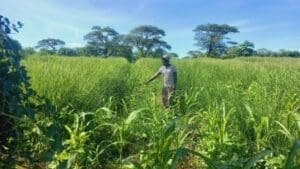
“Unless livestock can be better managed and controlled land degradation will continue”. Land restoration and transferring knowledge is not for the faint hearted!!
Since the introduction of Vetiver Grass in Kerio Valley in 2014 it has been challenging for people to understand its application, and even if understood most are not ready to try. All livestock farmers leave their animals to roam in search of pasture — very few fence their properties. The climate is harsh and water is scarce. However one lady, Joyce Wafula, used vetiver to conserve water and controlled soil erosion and has succeeded. She approached Samuel Teimuge, bought the grass from him, and received training on her farm.
Samuel Teimuge helped a group to register a Community Based Organization called, “Konyasoy” (healer of the Valley) Vetiver Network. Most of the members have Vetiver Grass but have not yet implemented any activity. Most of the people fence their properties using thorn trees and shrubs that are ineffective and rot after harvest of their crops.
Through awareness, media and visits to Teimuge’s farm, two farmers, Mr. Kemboi from Koimur village and Wilson Cheum have approached Teimuge to help save their small dams from silting up by applying on farm vetiver grass hedgerows, and stabilizing the dam structure with vetiver.
Mr. Kemboi has two dams but has not protect the area from animals destruction of the grass when planted. Another farmer is Mr. Wilson Cheum who is a citrus farmer in Kabokbok village — his small dam is in danger of huge silt during the coming rains.
On Teimuge’s farm at Kapsoo village there is a deep gully that if not stabilized will do serious damage to the farm. He has planted Vetiver grass along the gully with some success. The farmers across the gully hopefully will learn from this and do the same.
 Research News
Research News
Exploring the Therapeutic Potential of Chrysopogon zizanioides Essential Oil: A Comprehensive Study on Its Chemical Composition, Thermal Analysis, and Biological Activities … by Vikas Jha et al
Abstract: Natural bioactive compounds sourced from plants and plant parts have become integral to drug discovery as natural products. The over reliance on synthetic drugs has adversely affected human health. This study focuses on the essential oil from Chrysopogon zizanioides, commonly known as “Vetiver” to explore its medicinal value. The oil underwent various analytical and biological assessments. Extraction involved hydro-distillation of the roots, and GC-MS analysis unveiled its composition. FAME analysis provided insights into fatty acid composition. Infrared spectroscopy identified different functional groups. Thermal stability was gauged using TG-DTA and DSC methods. The essential oil’s antibacterial potency was tested against bacterial strains. Antimalarial and anti-tuberculosis potential were evaluated against Plasmodium falciparum and Mycobacterium tuberculosis, respectively. Vetiver essential oil’s ability to counter free radicals was determined via the DPPH reagent. Its impact on biofilm produced by 5 cultures was studied. The essential oil’s effects on cancerous (HeLa) and normal (CHO) cell lines were assessed using the MTT assay. In conclusion, Chrysopogon zizanioides essential oil exhibits considerable potential with diverse activities. It could serve as a non-toxic alternative for infection prevention and find utility in the food industry. Full paper at this link.
Dead-end trap plants as an environment-friendly IPM tool: A case study of the successful use of vetiver grass in China by Liang-De Tang et al
Abstract: A dead-end trap plant is a plant species that is highly attractive for oviposition and other activities of target pests, but on which they cannot complete their development, reproduction or survival. Due to its unique insecticidal mechanism and environment-friendly characteristics, it has received increasing attention in recent years. There are many species that can be used as trap plant, but few of them can be used as dead-end trap plants. These plants are commonly utilized for lepidopteran pest management in graminaceous crops, cruciferous vegetables and other cropping systems. At present, vetiver grass, Chrysopogon zizanioides, is widely used in the integrated pest management (IPM) of rice borers in southern China as an alternative to chemical pesticides. This article lists plant species that can be used as dead-end trap plants, together with he target pests and relevant cropping systems. In addition, the trapping principle and insecticidal mechanism of dead-end traps is reviewed, and the application of vetiver grass as a dead-end trap in rice borer IPM introduced. The future research directions of dead-end trap plants towards the protection of crops are also discussed. Link to paper
Experimental Evaluation of Additional Shear Strength for Vetiver Root-Reinforced Soil By Faria Fahim Badhon et al
Abstract: Slope instability-related damage is a major issue all over the world, including Bangladesh. Every year, slope failure occurs all over the country and causes major financial losses. A variety of methods are available for addressing this issue, but conventional slope protection methods require large and long-term investments. Hard engineering solutions can also be temporary, only transferring the problem from one location to another. A viable solution to this problem may be to use bio-engineering technology applying vegetation. Vegetation as a bio-engineering technique for slope stabilization can improve the shear strength and reduce the erosion potential of soils. The objective of this study is to evaluate the effectiveness of vegetation in improving the shear strength of soil. Vetiver grass which is a commonly found in Bangladesh was selected for the study. Roots were collected from uprooted vetiver grass found in a naturally grown land. To prepare the root-reinforced soil samples, roots were chopped according to different lengths (1.25–5 cm) and mixed in different root content (3%–12% of the dry weight of the soil sample) and moisture content of soil (10%–25%). It was observed that root-reinforced soil samples have a maximum of 88.2% higher shear strength compared to root-free samples. The added cohesion of vetiver rooted soil has a positive correlation with the root length, but for the root content shear strength increases up to an optimum root content and then decreases. The results from the present study have also been compared to the previous studies and found in good agreement with each other. Link to paper
Potentials of mycorrhizal fungi in altering eight biomechanical properties of plant roots by Xun Wen Chen et al.,
Abstract: Arbuscular mycorrhizal (AM) fungi are ubiquitous and impactful symbionts of most land plants and can regulate essential ecological processes. AM fungi can increase the cellulose content of root cell walls and hence the root tensile strength of grass. How AM fungi can alter other essential biomechanical properties is not clear. This study aims to study the contribution of AM fungi in altering biomechanical properties by comparing mycorrhizal and non-mycorrhizal roots. We inoculated three fungal species to vetiver grass (Chrysopogon zizanioides) for comparison. Eight root biomechanical properties (i.e., yield strain, yield stress, break strain, tensile strength, Young’s modulus, plastic modulus, plastic strain, and toughness) were determined for each root using a newly developed Fortran language-based program. Inoculating AM fungi decreased both Young’s modulus and plastic modulus by 23% and 17%, respectively, versus control, although it was species-dependent. Yield stress was not significantly affected, but tensile strength was increased by 7%–17% upon fungal symbiosis. Together with the increases in break strain by 15%–20%, mycorrhizal roots possessed a notably higher toughness than non-mycorrhizal roots by up to 36%. Greater root cohesion of mycorrhizal roots confirmed the enhanced (1.5-fold) factor of safety in the soil-root system. Our findings imply that AM fungi are of significant interest in plant biomechanics and geotechnical engineering. Applying AM fungi on soil slopes has considerable potential to improve vegetation and stability of green slopes. Link to paper
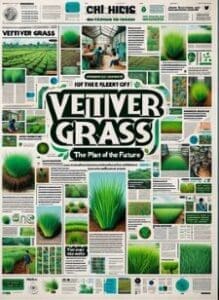 From the Newspapers
From the Newspapers
Father and Son Combat Erosion by Vetiver Grass (Papua New Guinea – trained by Robinson Vanoh)
Vetiver grass offers promising solution to soil erosion and landslide repair (USA)
An Asian grass helps Mexican farmers build resilience to climate change (Mexico)
 Some recent videos
Some recent videos
A Greenway to landslip Prevention
How to reforest a steep slope without swales or irrigation 🌱🌿🌳
Vetiver Grass Revitalizes Rural Kenya: A Locally Led Adaptation Story
Vetiver System for gully erosion rehabilitation
The use of vetiver to produce natural fertiliser – Chazo Juan Community – Bolivar, Ecuador
Vetiver System as a Green Engineering Tool in Dominica
Vetiver business for sale
Dave and Anna Stirling have played an important role in Europe and the Mediterranean region in the promotion of the Vetiver System for which we are all grateful. They are selling their propertyincluding the vetiver plant sales business – “VetiverSpain“. The property and business is located at Sayalonga, midway between Malaga and Motril, Spain. You can find info about the property/business at https://vetiverspain.com/ and https://esalesinternational.com/property/luxury-5-bed-villa-business-for-sale-in-sayalonga-malaga-spain/, and can contact Dave and Anna at: [email protected] — nice place for a retirement and a side business that might keep you busy!